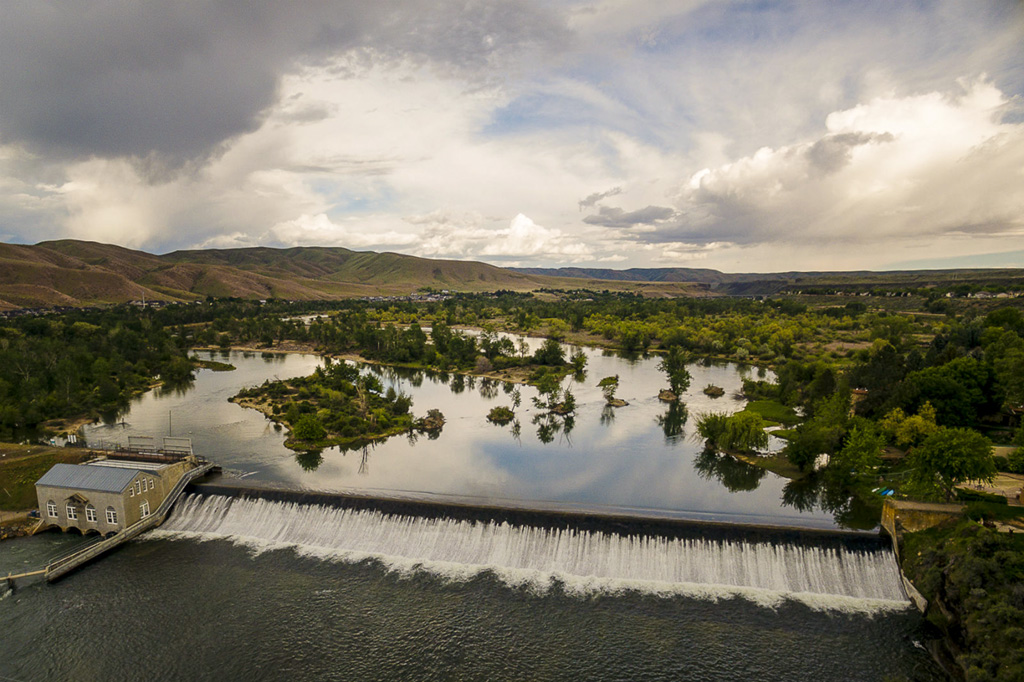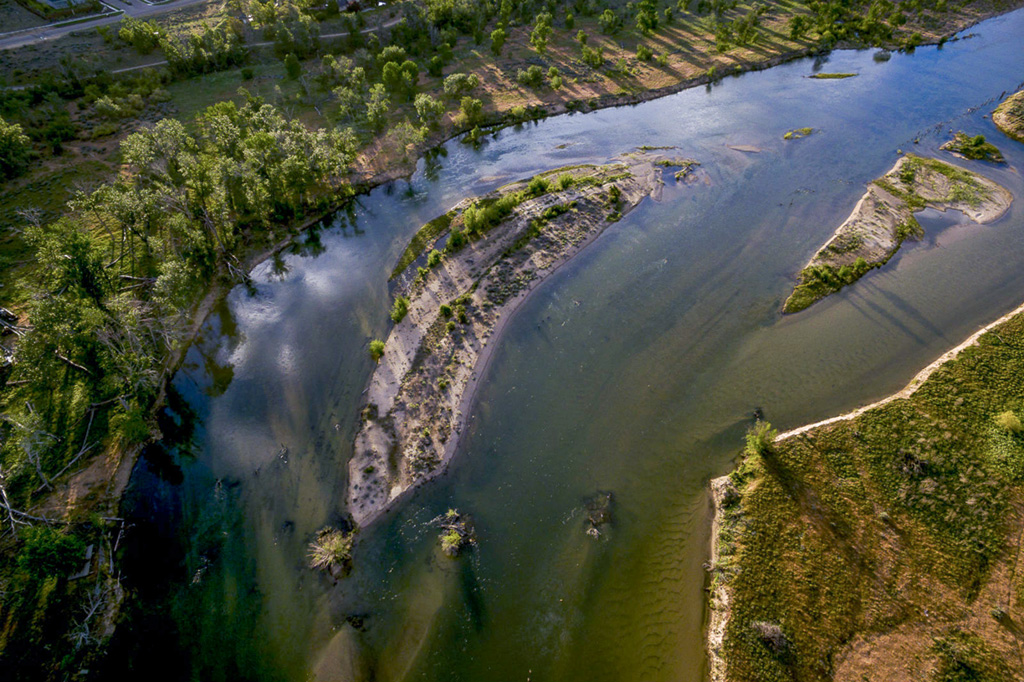Wrapping down Warm Springs Avenue and north of Surprise Way in Boise is an oblong parcel of land. It is an area you’ve probably driven by but didn’t realize it.
The Barber Pool Conservation Area (BPCA) spans a stretch of riverbanks, sandy islands and calm water on the east end of Boise. From the trout that navigate its ripples, to
the mule deer that graze on its grasses and the bald eagles that nest in its black cottonwood trees, hundreds of species of flora and fauna grow and live in the area, undisturbed by human activity.
There are no trails or access points for people in the private wildlife refuge, which is owned by the Idaho Foundation for
Public Lands (IFPL). It covers 425 acres between Barber Dam and the Boise Diversion Dam, with the

Barber Dam. Photo : Idaho Foundation for Parks and Lands / alpenglowpress.com
Boise River to the north and New York Canal to the south, and is one of the largest areas of its kind within an urban city in America.
In the winter, bald eagles perch in the large-growth cottonwoods of Barber Pool, one of the species’ last active nesting sites in Boise. The health of the cottonwoods is in decline, and the IFPL has quietly been conducting a private capital campaign to mitigate this damage and other issues within the pool. When completed, the $3 million raised will be used to restore and protect this riparian area for future generations of its inhabitants.
The Barber Pool first surfaced in Boise’s history of modern development in 1864, when Isaac N. Coston from New York established a ranch on the south bank of the river. He built a small cabin, which now stands in the Pioneer Village at Julia Davis Park, and became a successful farmer. His family moved on from the area as the lumber industry grew in Boise.
The site Coston farmed was inundated with water in 1906 when the Barber Lumber Company constructed a sawmill on the riverbank, a dam in the river, and a millpond in between. The company’s plan was to drive logs down the river to supply the mill, but silt from upstream mining threatened to fill the pond when this plan was implemented, so the technique was soon abandoned.
As the lumber companies merged and favored the railway over the river for transport, the millpond became owned though unused by Boise Cascade. When Lucky Peak Dam was built in 1955, the annual springtime flooding of the pool ended, and with it, the cottonwood forests stopped growing. In 1978, Boise Cascade donated much of the pool to the Idaho Foundation for Parks and Lands, and in 2002, the IFPL joined 11 other entities to form Friends of the Barber Pool. These groups conducted exhaustive surveys of the pool and its islands, creating an inventory and analysis of the ecosystem there and drafting a master plan and recommendations for its restoration.
“One of the things that the core study said is that the biggest potential damage to the Barber Pool is both domestic pets and human interaction,” says Brian McDevitt, who is an IFPL board member and whose home overlooks the pool. “Our goal is to minimize both of those.”
More than 40 years have passed since the foundation became stewards of the pool. They have worked hard to acquire all of the privately held land around it, including a 12-acre parcel on its northern side that’s adjacent to the Idaho Shakespeare Festival amphitheater.
The festival has played an important role in the conservation effort and was one of the 12 groups in the Friends of the Barber Pool coalition. Mark Hofflund, the executive director of the Idaho Shakespeare Festival, says its proximity to the pool continues the tradition of major classic amphitheaters that prioritized their natural environment.
“[The Greeks and Elizabethans] always got their communities into a space that had a great view and appreciation of the natural world around them,” he says. “The view is reversed, we look up into the hills, and that inspiration is huge for our audiences, whether they’re conscious of it. It’s a transformative experience, seeing, feeling and going into a habitat designed to be appreciated.”
The foundation is now privately fundraising for the purchase of the Gregerson property, a 34-acre parcel that is the last privately held parcel in the Barber Pool and the largest remaining piece of privately held riverfront property in Boise.
The IFPL is also working to purchase water rights to effectively irrigate the conservation area each spring, mimicking the floods that created its habitats. As climate change creates longer dry seasons, the IFPL’s methods will protect the Barber Pool for long-term prosperity.
The foundation, being conservative, recognizes the rights of property owners and the rights of citizens in Idaho to use the river. They plan to implement an education program for users on how to pass through the pool without disturbing its inhabitants.
“There’s going to be a natural use of the waterway for recreation, and we’re absolutely not trying to fight it,” McDevitt says. “Enjoy a scenic one or two hour float all the way to the Ada County take-out and recognize how unique this is that you can do this inside a city limit.”

